
Illustrative Math Alignment: Grade 8 Unit 3
Functions and Volume
Lesson 11: Filling Containers
Use the following Media4Math resources with this Illustrative Math lesson.
| Thumbnail Image | Title | Body | Curriculum Topic |
|---|---|---|---|
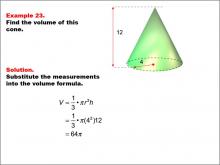
|
Math Example--Volume Concepts--Calculating Volume: Example 23 | Math Example--Volume Concepts--Calculating Volume: Example 23TopicVolume Description
A cone with a height of 12 and a radius of 4. The image shows how to calculate its volume using the cone volume formula (V = 1/3 * π * r2 * h). This image illustrates Example 23: Find the volume of a cone. The formula used is V = (1/3) * π * r2 * h, where r = 4 and h = 12. Substituting these values gives V = (1/3) * π * (42) * 12 = 64π. |
Volume |

|
Math Example--Volume Concepts--Calculating Volume: Example 24 | Math Example--Volume Concepts--Calculating Volume: Example 24TopicVolume DescriptionA cone with a height labeled as y and a radius labeled as x. The image shows how to calculate its volume using the cone volume formula (V = 1/3 * π * r2 * h). This image illustrates Example 24: Find the volume of a cone. The formula used is V = (1/3) * π * r2 * h, where r = x and h = y. Substituting these variables gives V = (x^2 * y)/3 * π. |
Volume |
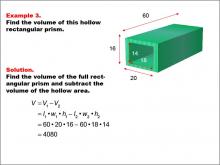
|
Math Example--Volume Concepts--Calculating Volume: Example 3 | Math Example--Volume Concepts--Calculating Volume: Example 3TopicVolume DescriptionA hollow rectangular prism with outer dimensions: length = 60, width = 20, and height = 16. The inner hollow part has dimensions: length = 60, width = 18, and height = 14. The image shows how to subtract volumes to find the hollow volume. This image illustrates Example 3: The caption explains how to calculate the volume of a hollow rectangular prism by subtracting the inner volume from the outer volume. V = (60 * 20 * 16) - (60 * 18 * 14) = 4080. |
Volume |
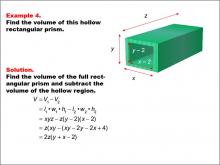
|
Math Example--Volume Concepts--Calculating Volume: Example 4 | Math Example--Volume Concepts--Calculating Volume: Example 4TopicVolume DescriptionA hollow rectangular prism with outer dimensions labeled as x, y, and z, and inner hollow dimensions labeled as x - 2 and y - 2. The image shows a symbolic calculation for finding the hollow volume using variables. This image illustrates Example 4: The caption describes how to calculate the volume of a hollow rectangular prism by subtracting the inner volume from the outer volume using variables: V = xyz - z(y - 2)(x - 2) = 2z(y + x - 2). |
Volume |
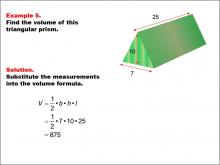
|
Math Example--Volume Concepts--Calculating Volume: Example 5 | Math Example--Volume Concepts--Calculating Volume: Example 5TopicVolume DescriptionThe image shows a triangular prism with dimensions labeled as base (7), height (10), and length (25). It is part of an example on how to calculate the volume of a solid triangular prism. This image illustrates Example 5: "Find the volume of this triangular prism." The solution involves substituting the given measurements into the volume formula for a triangular prism: V = 1/2 * b * h * l = 1/2 * 7 * 10 * 25 = 875. |
Volume |
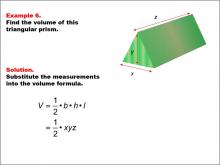
|
Math Example--Volume Concepts--Calculating Volume: Example 6 | Math Example--Volume Concepts--Calculating Volume: Example 6TopicVolume DescriptionThe image depicts a triangular prism with dimensions labeled as x, y, and z. The example demonstrates how to calculate the volume using a general formula for a triangular prism. This image illustrates Example 6: "Find the volume of this triangular prism." The solution uses the formula V = 1/2 * b * h * l, which is simplified to V = 1/2 * x * y * z.. |
Volume |
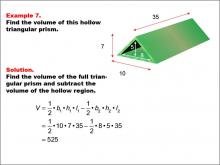
|
Math Example--Volume Concepts--Calculating Volume: Example 7 | Math Example--Volume Concepts--Calculating Volume: Example 7TopicVolume DescriptionThe image shows a hollow triangular prism with outer dimensions labeled as base (10), height (7), and length (35), and inner dimensions labeled as base (8) and height (5). The example calculates the volume by subtracting the hollow region from the full prism. This image illustrates Example 7: "Find the volume of this hollow triangular prism." The solution calculates the full volume using V = 1/2 * b1 * h1 * l1 - 1/2 * b2 * h2 * l2, which simplifies to V = 1/2 * 10 * 7 * 35 - 1/2 * 8 * 5 * 35 = 525.. |
Volume |
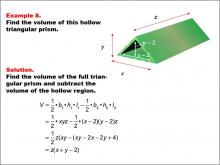
|
Math Example--Volume Concepts--Calculating Volume: Example 8 | Math Example--Volume Concepts--Calculating Volume: Example 8TopicVolume DescriptionThis image shows a hollow triangular prism with outer dimensions labeled as x, y, and z, and inner dimensions reduced by 2 units each. It demonstrates how to calculate the volume by subtracting the hollow region from the full prism. This image illustrates Example 8: "Find the volume of this hollow triangular prism." The solution uses V = 1/2 * b1 * h1 * l1 - 1/2 * b2 * h2 * l2, which simplifies to V = z(xy - (x - 2)(y - 2)) = z(x + y - 2).. |
Volume |
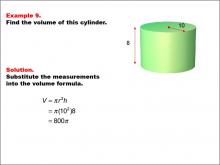
|
Math Example--Volume Concepts--Calculating Volume: Example 9 | Math Example--Volume Concepts--Calculating Volume: Example 9TopicVolume Description
A green cylinder with a radius of 10 units and a height of 8 units. The radius is marked on the top surface, and the height is marked on the side. This image illustrates Example 9: The task is to find the volume of the cylinder. The volume formula V = πr2h is used. Substituting the values r = 10 and h = 8, the volume is calculated as V= 800π. |
Volume |
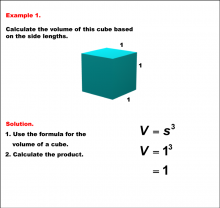
|
Math Example--Volume Concepts--Exploring Volumes of Cubes: Example 1 | Math Example--Volume Concepts--Exploring Volumes of Cubes: Example 1
This is part of a collection of math examples that focus on volume. |
Volume |
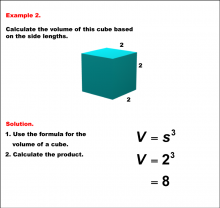
|
Math Example--Volume Concepts--Exploring Volumes of Cubes: Example 2 | Math Example--Volume Concepts--Exploring Volumes of Cubes: Example 2
This is part of a collection of math examples that focus on volume. |
Volume |
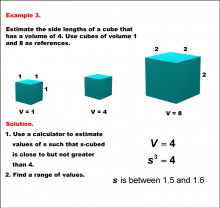
|
Math Example--Volume Concepts--Exploring Volumes of Cubes: Example 3 | Math Example--Volume Concepts--Exploring Volumes of Cubes: Example 3
This is part of a collection of math examples that focus on volume. |
Volume |
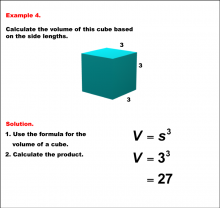
|
Math Example--Volume Concepts--Exploring Volumes of Cubes: Example 4 | Math Example--Volume Concepts--Exploring Volumes of Cubes: Example 4
This is part of a collection of math examples that focus on volume. |
Volume |
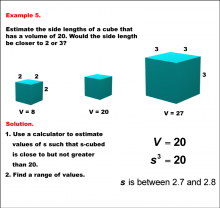
|
Math Example--Volume Concepts--Exploring Volumes of Cubes: Example 5 | Math Example--Volume Concepts--Exploring Volumes of Cubes: Example 5
This is part of a collection of math examples that focus on volume. |
Volume |
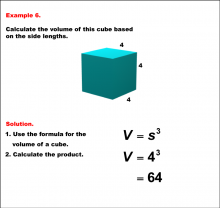
|
Math Example--Volume Concepts--Exploring Volumes of Cubes: Example 6 | Math Example--Volume Concepts--Exploring Volumes of Cubes: Example 6
This is part of a collection of math examples that focus on volume. |
Volume |

|
Math Example--Volume Concepts--Exploring Volumes of Cubes: Example 7 | Math Example--Volume Concepts--Exploring Volumes of Cubes: Example 7
This is part of a collection of math examples that focus on volume. |
Volume |
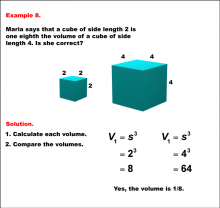
|
Math Example--Volume Concepts--Exploring Volumes of Cubes: Example 8 | Math Example--Volume Concepts--Exploring Volumes of Cubes: Example 8
This is part of a collection of math examples that focus on volume. |
Volume |
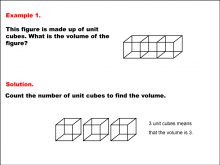
|
Math Example--Volume Concepts--Modeling Volume--Example 1 | Math Example--Volume Concepts--Modeling Volume--Example 1TopicVolume DescriptionThe image shows a rectangular prism made up of 3 unit cubes arranged in a single row. The example asks for the volume of the figure, and the solution involves counting the number of unit cubes. Example 1: The figure consists of 3 unit cubes. The caption reads: "Count the number of unit cubes to find the volume. 3 unit cubes means that the volume is 3." |
Volume |
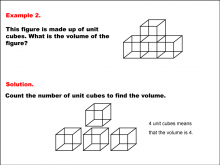
|
Math Example--Volume Concepts--Modeling Volume--Example 2 | Math Example--Volume Concepts--Modeling Volume--Example 2TopicVolume DescriptionThe image shows a figure made up of 4 unit cubes, with one cube stacked on top of another, forming an L-shape. The example asks for the volume, and the solution involves counting the cubes. Example 2: The figure consists of 4 unit cubes. The caption reads: "Count the number of unit cubes to find the volume. 4 unit cubes means that the volume is 4." |
Volume |
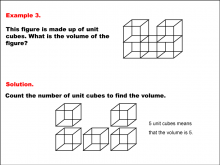
|
Math Example--Volume Concepts--Modeling Volume--Example 3 | Math Example--Volume Concepts--Modeling Volume--Example 3TopicVolume DescriptionThe image shows a figure made up of 5 unit cubes arranged in an irregular shape, with one cube raised above others. The example asks for the volume, and the solution involves counting the number of unit cubes. Example 3: The figure consists of 5 unit cubes. The caption reads: "Count the number of unit cubes to find the volume. 5 unit cubes means that the volume is 5." |
Volume |
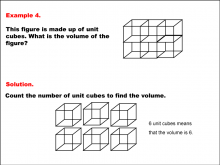
|
Math Example--Volume Concepts--Modeling Volume--Example 4 | Math Example--Volume Concepts--Modeling Volume--Example 4TopicFractions DescriptionThe image shows a rectangular prism made up of 6 unit cubes arranged in two layers (a top and bottom row). The example asks for the volume, and the solution involves counting all the cubes in both layers. Example 4: The figure consists of 6 unit cubes. The caption reads: "Count the number of unit cubes to find the volume. 6 unit cubes means that the volume is 6." |
Volume |
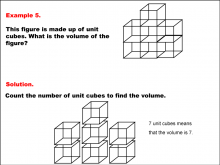
|
Math Example--Volume Concepts--Modeling Volume--Example 5 | Math Example--Volume Concepts--Modeling Volume--Example 5TopicFractions DescriptionThe image shows a 3D figure made up of unit cubes. The figure is stacked in a staggered manner, with some cubes placed directly on top of others. Below the figure, there is a breakdown showing the individual cubes counted to determine the volume. Example 5: The caption asks for the volume of the figure, which is made up of unit cubes. The solution involves counting the cubes to find the volume. |
Volume |
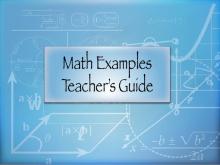
|
MATH EXAMPLES--Teacher's Guide: Equations of Parallel and Perpendicular Lines | MATH EXAMPLES--Teacher's Guide: Equations of Parallel and Perpendicular Lines
This Teacher's Guide provides an overview of the 32 worked-out examples that show how to find the equation of a line parallel or perpendicular to a given line and through a given point. This is part of a collection of teacher's guides. To see the complete collection of teacher's guides, click on this link. Note: The download is a PDF file.Related ResourcesTo see resources related to this topic click on the Related Resources tab above. |
Applications of Linear Functions and Graphs of Linear Functions |

|
MATH EXAMPLES--Teacher's Guide: Surface Area | MATH EXAMPLES--Teacher's Guide: Surface Area
This Teacher's Guide provides an overview of the 24 worked-out examples that show how to calculate the surface area of different three-dimensional figures. This is part of a collection of teacher's guides. To see the complete collection of teacher's guides, click on this link. Note: The download is a PDF file.Related ResourcesTo see resources related to this topic click on the Related Resources tab above. |
Surface Area |

|
MATH EXAMPLES--Teacher's Guide: Volume | MATH EXAMPLES--Teacher's Guide: Volume
This set of tutorials provides 24 examples of how to find the volume of various 3-dimensional geometric figures. This is part of a collection of teacher's guides. To see the complete collection of teacher's guides, click on this link. Note: The download is a PDF file.Related ResourcesTo see resources related to this topic click on the Related Resources tab above. |
Volume |

|
MATH EXAMPLES--Volume | MATH EXAMPLES--Volume
This set of tutorials provides 24 examples of how to find the volume of various 3-dimensional geometric figures. NOTE: The download is a PPT file. |
Volume |
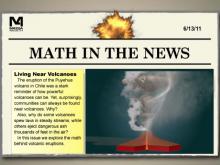
|
Math in the News: Issue 13--Living Near Volcanoes | Math in the News: Issue 13--Living Near Volcanoes
6/13/11. In this issue we explore the volcanic eruption in Chile that resulted in a huge plume of smoke and ash that was miles high. We explore the viscosity of lava that makes such eruptions possible. This is part of the Math in the News collection. To see the complete collection, click on this link. Note: The download is a PPT file.Related ResourcesTo see resources related to this topic click on the Related Resources tab above. |
Volume |
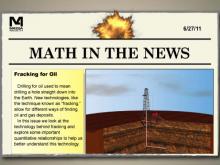
|
Math in the News: Issue 15--Fracking for Oil | Math in the News: Issue 15--Fracking for Oil
6/27/11. In this issue we look at the technology of hydraulic fracking. In particular, we estimate the amount of drilling required for such wells. This is part of the Math in the News collection. To see the complete collection, click on this link. Note: The download is a PPT file.Related ResourcesTo see resources related to this topic click on the Related Resources tab above. |
Volume |
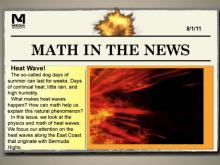
|
Math in the News: Issue 20--Heat Wave! | Math in the News: Issue 20--Heat Wave!
8/1/11. In this issue we look at the physics of air pressure and the forces that give rise to heat waves. This is part of the Math in the News collection. To see the complete collection, click on this link. Note: The download is a PPT file.Related ResourcesTo see resources related to this topic click on the Related Resources tab above. |
Data Analysis |
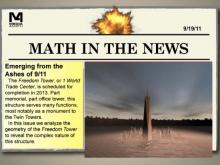
|
Math in the News: Issue 27--Emerging from the Ashes of 9/11 | Math in the News: Issue 27--Emerging from the Ashes of 9/11
9/19/11. To commemorate the 10-year anniversary of the 911, we look at the geometry and architecture of the Freedom Tower, currently under construction. This is part of the Math in the News collection. To see the complete collection, click on this link. Note: The download is a PPT file.Related ResourcesTo see resources related to this topic click on the Related Resources tab above. |
3-Dimensional Figures |
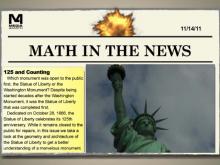
|
Math in the News: Issue 35--125 and Counting | Math in the News: Issue 35--125 and Counting
11/14/11. In this issue we commemorate the 125th anniversary of the Statue of Liberty. We also look at the geometry and architecture of this monument. This is part of the Math in the News collection. To see the complete collection, click on this link. Note: The download is a PPT file.Related ResourcesTo see resources related to this topic click on the Related Resources tab above. |
Surface Area and Volume |
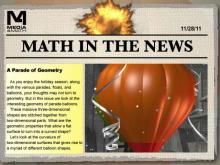
|
Math in the News: Issue 37--A Parade of Geometry | Math in the News: Issue 37--A Parade of Geometry
11/28/11. In this issue we look at the geometry of parade balloons. This is part of the Math in the News collection. To see the complete collection, click on this link. Note: The download is a PPT file.Related ResourcesTo see resources related to this topic click on the Related Resources tab above. |
Surface Area and Volume |

|
Math in the News: Issue 38--December 7, 1941 | Math in the News: Issue 38--December 7, 1941
12/7/11. In this issue we look at the heroic work of salvaging and retrofitting many of the ships sunk during the attack on Pearl Harbor. This is part of the Math in the News collection. To see the complete collection, click on this link. Note: The download is a PPT file.Related ResourcesTo see resources related to this topic click on the Related Resources tab above. |
Surface Area and Volume |
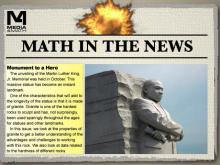
|
Math in the News: Issue 39--Monument to a Hero | Math in the News: Issue 39--Monument to a Hero
12/12/11. In this issue we look at the MLK Memorial and the special properties of granite that presented some design challenges in the construction of the statue. This is part of the Math in the News collection. To see the complete collection, click on this link. Note: The download is a PPT file.Related ResourcesTo see resources related to this topic click on the Related Resources tab above. |
Surface Area and Volume |
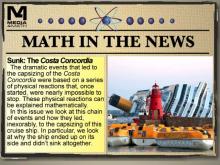
|
Math in the News: Issue 44--Sunk: The Costa Concordia | Math in the News: Issue 44--Sunk: The Costa Concordia
January 2012. In this issue of Math in the News we analyze how the Costa Concordia sank. This is part of the Math in the News collection. To see the complete collection, click on this link. Note: The download is a PPT file.Related ResourcesTo see resources related to this topic click on the Related Resources tab above. |
Surface Area and Volume |
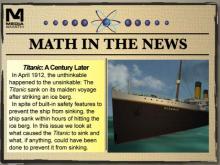
|
Math in the News: Issue 53--Titanic: A Century Later | Math in the News: Issue 53--Titanic: A Century Later
April 2012. In this issue of Math in the News we analyze the sinking of the Titanic. It has been a hundred years, yet the story of the sinkin g of the Titanic still fascinates. This is part of the Math in the News collection. To see the complete collection, click on this link. Note: The download is a PPT file.Related ResourcesTo see resources related to this topic click on the Related Resources tab above. |
Surface Area and Volume |
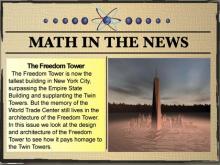
|
Math in the News: Issue 56--The Freedom Tower | Math in the News: Issue 56--The Freedom Tower
May 2012. In this issue of Math in the News we look at the architecture of the Freedom Tower, now that it has become the tallest building in NYC. This is part of the Math in the News collection. To see the complete collection, click on this link. Note: The download is a PPT file.Related ResourcesTo see resources related to this topic click on the Related Resources tab above. |
3-Dimensional Figures |
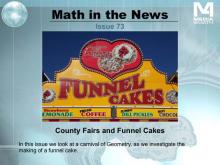
|
Math in the News: Issue 73--County Fairs and Funnel Cakes | Math in the News: Issue 73--County Fairs and Funnel Cakes
August 2013. In this issue we look at the geometry of funnel cakes. You'll like the sweet results. This is part of the Math in the News collection. To see the complete collection, click on this link. Note: The download is a PPT file.Related ResourcesTo see resources related to this topic click on the Related Resources tab above. |
Surface Area and Volume |

|
Math in the News: Issue 75--A Swim for the Ages | Math in the News: Issue 75--A Swim for the Ages
August 2013. In this issue we look at Diana Nyad's remarkable swim from Cuba to Florida. It becomes an opportunity to explore Average Speed. This is part of the Math in the News collection. To see the complete collection, click on this link. Note: The download is a PPT file.Related ResourcesTo see resources related to this topic click on the Related Resources tab above. |
Data Analysis |
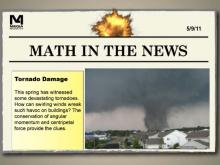
|
Math in the News: Issue 8--Tornado Damage | Math in the News: Issue 8--Tornado Damage
5/9/11. In this issue we look at tornado season. In particular we study why the swirling winds of a tornado are so damaging. This is part of the Math in the News collection. To see the complete collection, click on this link. Note: The download is a PPT file.Related ResourcesTo see resources related to this topic click on the Related Resources tab above. |
Data Analysis |
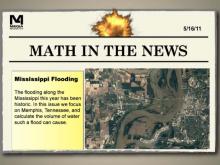
|
Math in the News: Issue 9--Mississippi Floods | Math in the News: Issue 9--Mississippi Floods
5/16/11. In this issue we look at the flooding along the Mississippi. In particular we analyze the flooding along Memphis, Tennessee. We develop a model for predicting the amount of flooding. This is part of the Math in the News collection. To see the complete collection, click on this link. Note: The download is a PPT file.Related ResourcesTo see resources related to this topic click on the Related Resources tab above. |
Volume |
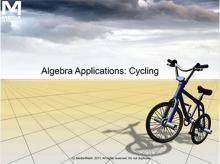
|
Promethean Flipchart: Algebra Applications: Cycling | The relationship between slope and grade in cycling is explored. Go on a tour of Italy through the mountains of Tuscany and apply students' understanding of slope. Note: The download for this resources is the Promethean Flipchart. To access the full video: [Algebra Applications: Linear Functions, Segment 2: Cycling]: https://www.media4math.com/library/video-algebra-applications-linear-functions-segment-2-cycling This video includes a Video Transcript: [Algebra Applications: Linear Functions, Segment 2: Cycling]: https://www.media4math.com/library/video-transcript-algebra-applications-linear-functions-segment-2-cycling |
Applications of Linear Functions |

|
Promethean Flipchart: Algebra Applications: Exercise | Exercise needs to become a consistent part of everyone's lifestyle. In particular, aerobic exercises, which vigorously exerts the heart, is an important form of exercise. The maximum heart rate from aerobic exercise is a linear function dependent on age. Students are asked to develop a data table based on the function. Note: The download for this resources is the Promethean Flipchart. To access the full video: [Algebra Applications: Linear Functions, Segment 4: Exercise]: https://www.media4math.com/library/video-algebra-applications-linear-functions-segment-4-exercise |
Applications of Linear Functions |
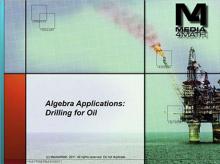
|
Promethean Flipchart: Algebra Applications: Oil Drilling | The potential for oil exploration in the controversial Alaska National Wildlife Refuge (ANWR) sets the scene for this problem. A linear regression of oil consumption data over the past 25 years reveals an interesting pattern. How could new oil fields like ANWR help in breaking our dependence on foreign oil? Note: The download for this resources is the Promethean Flipchart. To access the full video [Algebra Applications: Linear Functions, Segment 3: Oil Exploration]: https://www.media4math.com/library/video-algebra-applications-linear-functions-segment-3-oil-exploration |
Applications of Linear Functions |

|
Promethean Flipchart: Algebra Nspirations: Linear Functions | In this program, internationally acclaimed mathematics educator Dr. Monica Neagoy, explores the nature of linear functions through the use TI graphing calculators. Examples ranging from air travel, construction, engineering, and space travel provide real-world examples for discovering algebraic concepts. All examples are solved algebraically and then reinforced through the use of the TI-Nspire. Algebra teachers looking to integrate hand-held technology and visual media into their instruction will benefit greatly from this series. Concepts explored: Standard form, slope-intercept form, point-slope form, solving linear equations Note: The download for this resources is the Promethean Flipchart. This video includes a Teacher's Guide: https://www.media4math.com/library/algebra-nspirations-teachers-guide-linear-functions |
Applications of Linear Functions |
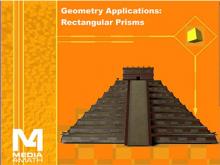
|
Promethean Flipchart: Geometry Applications: 3D Geometry 1 | Rectangular Prisms. Mayan pyramids are essentially stacks of rectangular prisms. The volume of each successive level is a percentage decrease of its lower neighbor. This introduces the notion of a geometric sequence and series, including an infinite series. Note: The download for this resources is the Promethean Flipchart. For access to the full video [Geometry Applications: 3D Geometry, Segment 2: Pyramids]: https://media4math.com/library/geometry-applications-3d-geometry-segment-2-pyramids This video includes a Video Transcript [Video Transcript: Geometry Applications: 3D Geometry, Segment 2: Pyramids]: https://www.media4math.com/library/video-transcript-geometry-applications-3d-geometry-segment-2-pyramids |
Applications of 3D Geometry |
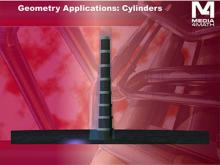
|
Promethean Flipchart: Geometry Applications: 3D Geometry 2 | The Shanghai Tower in China is a stack of cylindrical shapes, where each successive layer is a percentage decrease of its lower neighbor. As with the previous section, this introduces the notion of a geometric sequence and series. Note: The download for this resources is the Promethean Flipchart. To access the full video [Geometry Applications: 3D Geometry, Segment 3: Cylinders]: https://media4math.com/library/geometry-applications-3d-geometry-segment-3-cylinders This video includes a Video Transcript [Video Transcript: Geometry Applications: 3D Geometry, Segment 3: Cylinders]: https://www.media4math.com/library/video-transcript-geometry-applications-3d-geometry-segment-3-cylinders
|
Applications of 3D Geometry |

|
Quizlet Flash Cards: Point-Slope Form | In this set of Quizlet flash cards test understanding of the point-slope form. Note: The download is the teacher's guide for using Media4Math's Quizlet Flash Cards. Related ResourcesTo see the complete Quizlet Flash Card Library, click on this link: https://media4math.com/Quizlet-Resources |
Point-Slope Form |

|
Quizlet Flash Cards: Slope-Intercept Form | In this set of Quizlet flash cards test understanding of the slope-intercept form. Note: The download is the teacher's guide for using Media4Math's Quizlet Flash Cards. Related ResourcesTo see the complete Quizlet Flash Card Library, click on this link: https://media4math.com/Quizlet-Resources |
Slope-Intercept Form |

|
Test Prep Interactive Quiz--Linear Functions | Test Prep Interactive Quiz--Linear Functions
This is part of a collection of self-scoring interactive math quizzes on a variety of topics. To see the complete of these quizzes, click on this link. Note: The download is the teacher's guide.Related ResourcesTo see additional resources on this topic, click on the Related Resources tab.Quiz LibraryTo see the complete collection of Quizzes, click on this link.ary">click on this link. |
Graphs of Linear Functions, Slope and Slope-Intercept Form |